Shostakovich, Stalingrad, Kharkov & Kursk
Sunday, April 19, 2009
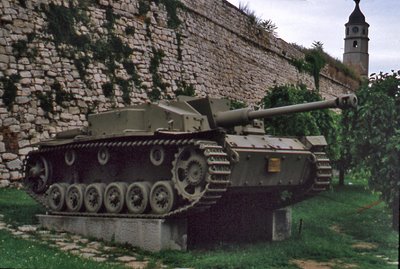
Around 1972 my friend Jorge Urrechega sold me (cheap) a new transistor (one of the first in those days) Acoustic Research amplifier with an accompanying and lovely Acoustic Research turntable. The turntable was a beauty of design and the amplifier had knobs that were the absolute necessary ones (5) all made of solid brass. I immediately bought an expensive Shure cartridge. I was almost all set for listening to good music as it should be listened to. Except I had no decent speakers and no way of getting any in Mexico City where there was an import ban on anything manufactured in the US. Jorge would come and we would play Vivaldi’s Gloria and Richard Strauss’ Also sprach Zarathustra, Op. 30. When the latter began with its fanfare that ended with a very low pedal bass sound from the organ Jorge would wince and almost cry. “You need some good speakers,"he told me. “I suggest you get the best that you can afford and these would be the Acoustic Research AR-3As."
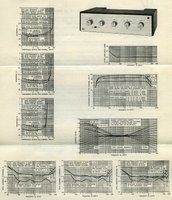
I had befriended one of my neighbors who lived at the end of our block in our Mexico City suburb of Arboledas. Alfarache was a blond/redhaired engineer who worked for the government petroleum company Pemex. I played volleyball on the street with my other neighbours but Alfarache disdained all sports. He was much keener about the weekend domino sessions. He was very good. But what separated him from most of my neighbours and made him somewhat of a loner was his penchant for listening to classical music, very loud in the comfort of his home. He looked down upon popular Mexican music and abhorred American pop. I guess he was a well-read snob. I liked his kind of music.
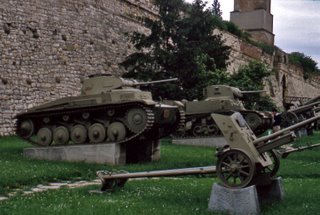
I told Alfarache of my problem. With a smile on his face he told me, “We are going to order a couple of hydraulic pumps from Houston and bring them into my office. I will deliver them to you in a couple of weeks. Now give me some money to buy them.”
Two weeks later Alfarache arrived at my door and we unpacked the most beautiful speakers (AR-3As) I had ever seen. We connected everything and I was just about to test my Strauss when Alfarache interrupted me, “Permit me Alex. Let’s listen to this first. And let’s play it real loud.” It was Dmitri Shostakovich’s Symphony No.5, Op. 47 with Kirill Kondrashin directing the Leningrad Orchestra.
I cannot stress here how this symphony changed my outlook towards Russian music. I had always only just tolerated the overly romantic Tchaikovsky. Alfarache mentioned that the second movement had a piano part where the piano sounded like the real percussion instrument it was supposed to be. That was the case. I remember it was a hot day but as the music played I was transported to a Russian winter. To this day this symphony is my favourite symphony.
Last night I went to see a live performance (my first) of Symphony No.5 at Shaughnessy Heights United Church. The orchestra playing it was the Vancouver Philharmonic Orchestra directed by Jin Zhang.
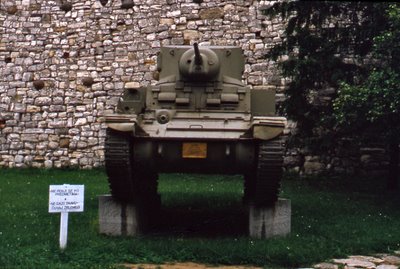
I went with some apprehension that I would find the performance lacking. I should not have been concerned. The performance was all that I imagined it to be. The piano part was as it had to be and the rest of the orchestra fluctuated between a bitter sweetness to loud triumphant parts. It was in the fourth and last movement, Allegro non troppo that I saw five percussionists all smile as they smashed their instruments with no apparent restraint. From the vantage of my seat on the fourth row it was really loud, it was gloriously loud. I am sure that Alfarache would have smiled and told me, “This is how music must be heard.”
But something else happened during last night’s performance. That first movement is an extreme cold and sobering experience. It is of despair. For me it is about the siege of Stalingrad even though I know Shostakovich wrote this work in 1937. I know that the subtitle of the work (he was attempting to rehabilitate himself with the Russian authorities and perhaps avoid being sent to Stalin’s gulag who had hated his last work, the opera Lady Macbeth of Mtsensk) A Soviet Artist’s Practical Creative Reply to Just Criticism. As the music progressed I saw tanks and imagined their rumbling and the roar of their guns. I saw plains of snow and Russian and German soldiers in long winter coats. I could almost hear the sound of the tank's metal tracks.
The German army was soundly defeated by the Russians at Stalingrad between November 1942 and January 1943. Then at the Third Battle of Kharkov, between February 20 and March 18, 1943 the Germans under the command of General Erich von Manstein almost compensated for their prior loss. And then between July and August 1943 the Russians defeated the Germans in one of the biggest tank battles of all time at Kursk. Tanks figured in two of these battles. In the end the Russian tanks were victors over the German tanks. While some of the German tanks may have been better machines they could not compensate for the many more tanks that the Russians had at their disposal.
When I heard the kettle drums in the last movement I heard the victorious Russian tanks in pursuit of the Germans who lost 1000 tanks and 100,000 men.
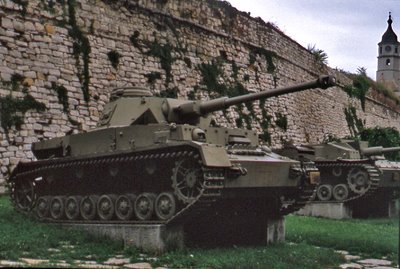
When I arrived home I went to my Yugoslavia file. I remembered I had photographed some tanks in a park by the Danube in Belgrade. I am sure amongst these there must be some of those Russian tanks.
Addendum courtesy of Ian McGuffie
First Photograph: German Stug III assault gun. That is a fixed "turret" that does not turn. To aim gun, tread turning was used.
Second Photograph: German Mark II Panzer and behind American M III Stewart
Third Photograph: Front view of M III Stewart
Fourth Photograph: German Mark IV Panzer. Ian McGuffie further comments that the Russians used American tanks (which they hated) in a Lend-Lease agreement with the US. He cannot understand why there are no Russian tanks in the Belgrade collection.






